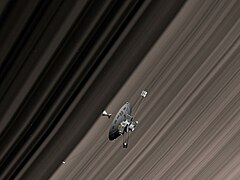Pioneer 11
| ||
 | ||
| Inne nazwy | Pioneer G | |
| Zaangażowani | ||
| Indeks COSPAR | 1973-019A | |
| Rakieta nośna | Atlas/Centaur/TE364-4 | |
| Miejsce startu | Cape Canaveral Air Force Station, Stany Zjednoczone | |
| Cel misji | Jowisz | |
| Cel misji | Saturn | |
| Orbita (docelowa, początkowa) | ||
| Czas trwania | ||
| Początek misji | 6 kwietnia 1973 (02:11:00 UTC) | |
| Koniec misji | listopad 1995 | |
| Wymiary | ||
| Masa całkowita | 258,5 kg | |
| Masa aparatury naukowej | 30,4 kg | |


Pioneer 11 – bezzałogowa sonda kosmiczna NASA, wyniesiona z przylądka Canaveral na Florydzie 6 kwietnia 1973 roku przy użyciu rakiety nośnej Atlas Centaur. Jako druga sonda kosmiczna w historii przeleciała w pobliżu Jowisza w 1974 roku. W 1979 roku Pioneer 11 stał się pierwszym obiektem zbudowanym przez człowieka, który zbliżył się do Saturna, odkrywając złożoność jego pierścieni.
Konstrukcja sondy
Masa sondy wynosiła 258,5 kg. Energii elektrycznej dostarczały 4 radioizotopowe generatory termoelektryczne (RTG) o całkowitej mocy przy starcie 155 W. Łączność zapewniała paraboliczna antena główna o średnicy 2,74 m oraz anteny pomocnicze.
Instrumenty naukowe
Na pokładzie sondy zostało zainstalowanych 12 instrumentów naukowych (do zestawu instrumentów z sondy Pioneer 10 dodano Fluxgate Magnetometer):
- Helium Vector Magnetometer – magnetometr
- Fluxgate Magnetometer – magnetometr transduktorowy
- Plasma Analyser – analizator plazmy
- Charged Particle Composition Instrument – detektor cząstek naładowanych
- Cosmic Ray Telescope – teleskop promieniowania kosmicznego
- Geiger Tube Telescopes – zestaw siedmiu liczników Geigera-Müllera
- Trapped Radiation Detector – detektor cząstek promieniowania uwięzionego
- Asteroid/ Meteoroid Detector (Sisyphus) – detektor planetoid i meteoroidów
- Meteoroid Detector – detektor meteoroidów
- Ultraviolet Photometer – fotometr ultrafioletu
- Imaging Photopolarimeter – fotopolarymetr obrazujący
- Infrared Radiometer – radiometr podczerwieni
Przebieg misji
Największe zbliżenie do Jowisza nastąpiło 3 grudnia 1974 roku. Sonda przeleciała w odległości 42 760 km od powierzchni chmur Jowisza, dokonując pierwszych obserwacji regionów okołobiegunowych tej planety, fotografując Wielką Czerwoną Plamę oraz mierząc masę księżyca Kallisto.
Pole grawitacyjne Jowisza wykorzystano do skierowania sondy w kierunku Saturna. Pioneer 11 zbliżył się do tej planety 1 września 1979 roku na odległość 20 900 km od jej widocznej powierzchni chmur. Podczas tego przelotu sonda dokonała pomiarów magnetosfery planety, odkryła pierścienie F i G, księżyc Epimeteusz[1] oraz określiła temperaturę panującą na Tytanie.
Odbiór danych z instrumentów sondy został oficjalnie zakończony 30 września 1995 roku. Ostatnia transmisja danych telemetrycznych z sondy została odebrana 24 listopada 1995 roku.
Na dzień 20 czerwca 2018 Pioneer 11 znajdował się w odległości 100.0091 au od Słońca, poza pasem Kuipera, oddalając się z prędkością 11,367 km/s (2,398 au rocznie)[2]. Pioneer 11 podąża w kierunku gwiazdozbioru Orła, za około 4 miliony lat dotrze w pobliże gwiazdy lambda Aquilae[3].
Zobacz też
Przypisy
- ↑ Obecność tego księżyca była podejrzewana na podstawie obserwacji teleskopowych wykonanych w 1966 roku, ale pozostawała niepotwierdzona.
- ↑ Spacecraft escaping the Solar System; Heavens-Above GmbH
- ↑ Don Savage, Ann Hutchison: Pioneer 11 to End Operations after Epic Career (ang.). W: Release: 95-163 [on-line]. NASA, 1995-09-25. [dostęp 2012-09-14].
Linki zewnętrzne
- Strona podająca aktualną pozycję sondy w czasie rzeczywistym
- NSSDC Master Catalog (ang.)
- Encyclopedia Astronautica (ang.)
| ||||
| |||||||||||||||||||
Media użyte na tej stronie
The flag of Navassa Island is simply the United States flag. It does not have a "local" flag or "unofficial" flag; it is an uninhabited island. The version with a profile view was based on Flags of the World and as a fictional design has no status warranting a place on any Wiki. It was made up by a random person with no connection to the island, it has never flown on the island, and it has never received any sort of recognition or validation by any authority. The person quoted on that page has no authority to bestow a flag, "unofficial" or otherwise, on the island.
NASA image of Pioneer 10's famed Pioneer plaque features a design engraved into a gold-anodized aluminum plate, 152 by 229 millimeters (6 by 9 inches), attached to the spacecraft's antenna support struts to help shield it from erosion by interstellar dust.
This artist's rendering shows the Galileo orbiter arriving at Jupiter on Dec. 7, 1995. A few hours before arrival, the orbiter will have flown within about 1,000 kilometers (600 miles) of Jupiter's moon lo, shown as the crescent to the left of the spacecraft. The sun is visible between Io and the spacecraft, near the spacecraft's long magnetometer. Jupiter is to the right. A faint white streak above the planet's clouds shows the atmospheric probe beginning to decelerate before it deploys a parachute for its scientific mission to collect data. About an hour after the probe mission, Galileo fired its rockets and entered orbit around Jupiter. The mission ended on Sept. 21, 2003, when the orbiter was deliberately destroyed in Jupiter's crushing atmosphere.
Pioneer 11 and Saturn rings on 1 September 1979.
NASA's Pioneer 11 image of Saturn and its moon Titan at the upper left. The irregularities in ring silhouette and shadow are due to technical anomalies in the preliminary data later corrected. Looking at the rings from left to right, the ring area begins with the outer A ring; the Encke Division; the inner A Ring; Cassini Division; the B Ring; the C Ring; and the innermost area where the D Ring would be. The image was made by Pioneer Saturn on Wednesday, August 26, 1979, and received on Earth at 3:19 pm PDT. Pioneer was, at that time, 2,846,000 kilometers (1,768,422 miles) from Saturn. The image was produced by computer at the University of Arizona and managed by NASA's Ames Research Center.







